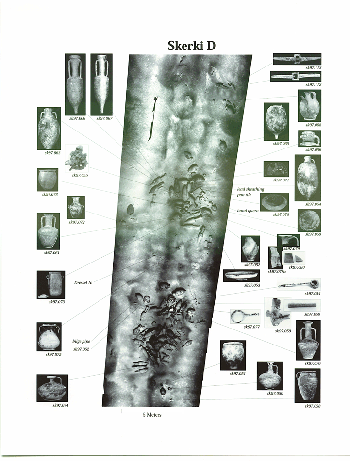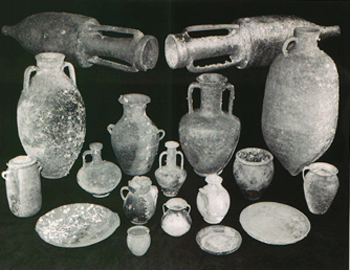
|
|
||
The amphoras are surprisingly varied and include at least 13 different forms originating in Italy, North Africa and Greece. These are mainly wine jars but also some for oil and garum, the prized fish sauce of the ancient Romans made from the guts of fish. Garum was used as both a popular condiment as well as for medicinal needs and brought high prices. Concentrated in nature, only a few garum jars are usually found with any shipment of wine.
Now the fishing lagoon is silted over and used as pasture land. But in Roman times a remarkable commercial complex existed at Cosa including: the harbor with concrete piers, a lighthouse, a commercial fish farm, factories for making amphoras, wine and fish products along with machinery for lifting fresh water from a gushing spring – all protected by a temple to Neptune on the hill above. Controlled and probably financed by the famous Sestius family who had an estate in the area and also probably owned ships, their wine and garum jars dominated trade in the western Mediterranean in the last quarter of the second and early first centuries B.C. The Sestii were one of the earliest exporters of Italian wine in the western Mediterranean and their enterprise goes back at least to the latter third century B.C.11 Skerki Wreck D provides startling new evidence for the importance of the port of Cosa and the export trade in wine and fish sauce by the Sestius family. |
||
|
8. Will in McCann 1987, pp.182-201. 9. SK97.066 and .067. 10. McCann 1987; McCann 1988. 11. The earliest known Sestius stamp was also found at Skerki Bank on a Graeco-Italic amphora (Will type 1d) from a different wreck site. This amphora can be dated in the early second century B.C. See McCann and Freed 1994, MJ89-29, p. 67, figs 46, 47 a-b, color fig. 16; A.M. McCann, "Lamps and the Dating of Roman Ports and Ships," in N. Goldman, ed., New Light from Ancient Cosa: Studies in Honor of Cleo Rickman Fitch (N.Y.,2001) pp. 13-34. For further chronology and recent discussion of the Sestius enterprise see E.L. Will, "Defining the Regna Vini of the Sestii", in Goldman, ibid., pp. 35-47. |


